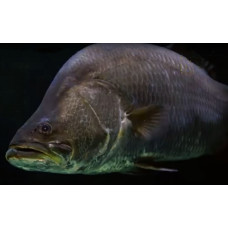Latin name
Lates calcarifer
Other names
Asian sea bass, giant sea perch, dangri, apahap.
Identification
Body elongated, compressed at the sides, with a high caudal peduncle. Head pointed, dorsal profile concave, becoming convex before the dorsal fin. Mouth large, slightly oblique. The upper jaw is set behind the vertical line behind the eyes. Teeth tufted, no fangs. There is a strong spike on the posterior margin of the premaxilla. Gill cover with a small spike and a toothed leathery flap above the beginning of the lateral line. There are 16-17 gill stamens on the lower part of the first gill arch. Scales large, ctenoid.
Features of fish fins
The dorsal fin has 7-9 hard and 10-11 soft rays; the barbed and soft parts of the dorsal fin are separated by a deep notch. Pectoral fins are short and rounded, with several strong teeth above their bases. Anal fin rounded with 3 barb rays and 7-8 soft rays. Caudal fin rounded.
Fish colouring
There are two types of coloration: olive-brown on the back with silver sides and a white belly (usually in juveniles), or green/blue on the back with silver sides and belly. There are no spots or stripes on the body or fins.
Distribution
Indo-West Pacific: eastern edge of the Persian Gulf to China, Taiwan and southern Japan, south to southern Papua New Guinea and northern Australia.
Habitat
Marine, freshwater, brackish, bottom dwelling, catadromous species. Depth: 10-40 m. Tropical: 15°C-28°C. Range: 49°N-26°S, 56°E-155°E. Occurs in coastal waters, estuaries and lagoons, in both clear and turbid waters.
Size
Maximum height 200 cm and maximum weight 60 kg. Maximum age: 35 years.
Behavior
A two-house fish that inhabits rivers before returning to estuaries to spawn. Larvae and juveniles inhabit brackish temporary marshes associated with estuaries, while older adults inhabit headwater streams. Prefers shelter on rugged banks, submerged logs, and overhanging vegetation.
Food and feeding habits
Predatory fish that feeds on fish and crustaceans.
Reproduction
Breeds in estuaries throughout the Indo-Pacific region. Adult males migrate downstream from freshwater habitats at the beginning of the monsoon season to spawn with females in estuaries and mudflats outside estuaries. They spawn during full and new moons, usually at the beginning of the tide that carries the eggs to the estuary. Spawning aggregations occur at or near estuaries. Adults and juveniles can live in fresh water, but require brackish water for embryonic development. Females are capable of laying large numbers of eggs, estimated at up to 2.3 million eggs per kilogram of body weight. They are protandrous hermaphrodites, meaning they change sex during their life cycle. Females are generally absent in the shorter length classes, but predominate in the longer length classes. Most fish mature as males and function as males for one or more spawning seasons before changing sex. Some females develop directly from immature fish. Likewise, some males may never change sex.
Fishing
It's a fishery.
Relationship with a person
It is an object of commercial cultivation. It is cultivated in many countries of the world.
| Classification | |
| Phylum | Chordata |
| Class | Actinopterygii |
| Squad | Perciformes |
| Family | Latidae |
| Genus | Lates |
| Species | L. calcarifer |
| Features | |
| Conservation status | Least Concern |
| Habitat | Bottom |
| Life span, years | 35 |
| Maximum body weight, kg | 60 |
| Maximum length, cm | 200 |
| Sailing speed, m/s | No information |
| Threat to people | Edible |
| Way of eating | Predator |
Barramundi
Tags: barramundi


